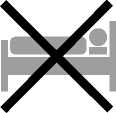Ibandronic Acid Actavis 150 Mg Film Coated Tablets
Out of date information, search another

Read all of this leaflet carefully before you start
taking this medicine.
• Keep this leaflet. You may need to read it again.
• If you have any further questions, ask your doctor or pharmacist.
• This medicine has been prescribed for you. Do not pass it on to others. It may harm them, even if their symptoms are the same as yours.
• If any of the side effects gets serious, or if you notice any side effects not listed in this leaflet, please tell your doctor or pharmacist.
• The full name of this medicine is Ibandronic Acid 150mg Film-coated Tablets but within the leaflet it will be referred to as Ibandronic acid tablets.
In this leaflet:
T| What Ibandronic acid tablets are and what they are used for
^ Before you take ^ How to take
Possible side effects T| How to store « Further information
j What Ibandronic acid tablets are and what they are used for
Ibandronic acid tablets belong to a group of medicines called bisphosphonates. They contain ibandronic acid. They do not contain hormones.
Ibandronic acid may reverse bone loss by stopping more loss of bone and increasing bone mass in most women who take it, even though they won't be able to see or feel a difference. Ibandronic acid may help lower the chances of breaking bones (fractures). This reduction in fractures was shown for the spine but not for the hip.
Ibandronic acid tablets are prescribed to you to treat postmenopausal osteoporosis because you have an increased risk of fractures. Osteoporosis is a thinning and weakening of the bones, which is common in women after the menopause. At the menopause, a woman's ovaries stop producing the female hormone, oestrogen, which helps to keep her skeleton healthy.
The earlier a woman reaches the menopause, the greater her risk of fractures in osteoporosis. Other things that can increase the risk of fractures include:
• not enough calcium and vitamin D in the diet
• smoking, or drinking too much alcohol
• not enough walking or other weight-bearing exercise
• a family history of osteoporosis.
Many people with osteoporosis have no symptoms. If you have no symptoms you may not know if you have the condition. However, osteoporosis makes you more likely to break bones if you fall or hurt yourself. A broken bone after the age of 50 may be a sign of osteoporosis. Osteoporosis can also cause back pain, height loss and a curved back.
Ibandronic acid tablets prevent loss of bone from osteoporosis, and help to rebuild bone. Therefore Ibandronic acid tablets make bones less likely to break.
A healthy lifestyle will also help you to get the most benefit from your treatment. This includes eating a balanced diet rich in calcium and vitamin D; walking or any other weight-bearing exercise; not smoking; and not drinking too much alcohol.
Continued top of next column AAAD3664
2) Before you take
Do not take Ibandronic acid tablets if you:
• are allergic (hypersensitive) to ibandronic acid or to any of the other ingredients of Ibandronic acid tablets.
• have certain problems with your oesophagus (the tube connecting your mouth with your stomach) such as narrowing or difficulty swallowing.
• can't stand or sit upright for at least one hour (60
minutes) at a time.
• have, or had in the past, low blood calcium. Please consult your doctor.
Children and teenagers
Do not give Ibandronic acid tablets to children or
teenagers.
Take special care with Ibandronic acid tablets:
Some people need to be especially careful while they're taking Ibandronic acid tablets. Check with your doctor;
• if you have any disturbances of mineral metabolism (such as vitamin D deficiency).
• if your kidneys are not functioning normally.
• if you have any swallowing or digestive problems.
• If you are under dental treatment or will undergo dental surgery. Tell your dentist that you are being treated with ibandronic acid.
Irritation, inflammation or ulceration of the oesophagus (the tube connecting your mouth with your stomach) often with symptoms of severe pain in the chest, severe pain after swallowing food and/or drink, severe nausea or vomiting may occur, especially if you do not drink a full glass of plain water and/or if you lie down within an hour of taking Ibandronic acid tablets.
If you develop these symptoms, stop taking Ibandronic acid tablets and tell your doctor straight away.
Taking other medicines
Please tell your doctor or pharmacist if you are taking, or have recently taken any other medicines, including medicines obtained without prescription. Especially: Supplements containing calcium, magnesium, iron or aluminium, as they could possibly influence the effect of ibandronic acid.
Aspirin and other non-steroidal anti-inflammatory medicines (NSAIDs) (including ibuprofen, diclofenac sodium and naproxen) may irritate the stomach and intestine. Bisphosphonates (like ibandronic acid) may also do so. So be especially careful if you take painkillers or anti-inflammatories while you're taking Ibandronic acid tablets.
After swallowing your monthly Ibandronic acid 150mg tablet, wait for 1 hour before taking any other medication, including indigestion tablets, calcium supplements or vitamins.
Taking Ibandronic acid tablets with food and drink
Do not take Ibandronic acid 150mg with food.
Ibandronic acid 150mg is less effective if it's taken with food.
You can drink plain water but no other drinks (see 3. How to take)
Pregnancy and breast feeding Do not take Ibandronic acid tablets if you're pregnant or breast feeding. If you're breast feeding, you may need to stop in order to take Ibandronic acid tablets.
Ask your doctor or pharmacist for advice before taking any medicine.
Driving and using machines
You can drive and use machines as it's very unlikely that Ibandronic acid tablets will affect your ability to drive and use machines.
Important information about some of the ingredients of Ibandronic acid tablets
Ibandronic acid tablets contain an ingredient called lactose. If you have been told by your doctor that you have an intolerance to some sugars, contact your doctor before taking this medicinal product.
Continued over page
How to take
Always take Ibandronic acid tablets exactly as your doctor has told you. If you're not sure about anything, ask your doctor or pharmacist.
The usual dose of ibandronic acid is one tablet once a month.
Taking your monthly tablet
It's important to follow these instructions carefully. They are designed to help your Ibandronic acid tablet reach your stomach quickly, so it's less likely to cause irritation.
• Take one Ibandronic acid 150mg tablet once a month.
• Choose one day of the month that will be easy to remember. You can choose either the same date (such as the 1st of each month) or the same day (such as the first Sunday of each month) to take your Ibandronic acid tablet. Choose the date that best fits your routine.
• Take your Ibandronic acid tablet at least 6 hours after you last had anything to eat or drink except plain water.
• Take your Ibandronic acid tablet
- after you first get up for the day, and
- before you have anything to eat or drink (on an
empty stomach).
• Swallow your tablet with a full glass of plain water
(at least 180ml). Do not take your tablet with mineral water, fruit juice or any other drinks.
• Swallow your tablet whole — do not chew it, crush it or let it dissolve in your mouth.
• For the next hour (60 minutes) after you've taken your tablet
- do not lie down; if you do not stay upright (standing or sitting), some of the medicine could leak back into your oesophagus.

• do not eat anything.

• do not drink anything (except plain water if you need it).
• do not take any other medicines.
• After you've waited for an hour, you can have your first food and drink of the day. Once you've eaten, it's OK to lie down if you wish, and to take any other medication you need.
Do not take your tablet at bedtime or before you get up for the day.
Continuing to take Ibandronic acid 150mg
tablets
It's important to keep taking Ibandronic acid tablets every month, as long as your doctor prescribes it for you. Ibandronic acid can treat osteoporosis only as long as you keep taking it.
If you take too many Ibandronic acid 150mg tablets
If you've taken more than one tablet by mistake, drink a full glass of milk and talk to your doctor straight away.
Do not make yourself vomit, and do not lie down - this could cause ibandronic acid to irritate your oesophagus.
If you forget to take a dose
If you forgot to take your tablet on the morning of your chosen day, do not take a tablet later in the day. Instead, consult your calendar and find out when your next scheduled dose is:
If your next scheduled dose is only 1 to 7 days away...
You should wait until the next scheduled dose is due and take it as normal; then, continue taking one tablet once a month on the scheduled days you've marked on your calendar.
If your next scheduled dose is more than 7 days away.
You should take one tablet the next morning after the day you remember; then, continue taking one tablet once a month on the scheduled days you've marked on your calendar.
Never take two Ibandronic acid tablets within the same week.
Continued top of next column AAAD3664
4 Possible side effects
Like all medicines, Ibandronic acid tablets can cause side effects although not everybody gets them.
Talk to a nurse or a doctor straight away if you notice any of the following serious side effects -you may need urgent medical treatment:
• rash, itching, swelling of your face, lips, tongue and throat, with difficulty breathing. You may be having an allergic reaction to the medicine.
• severe pain in the chest, severe pain after swallowing food or drink, severe nausea, or vomiting.
• flu-like symptoms (if any effects become troublesome or last more than a couple of days).
• pain or sore in your mouth or jaw
• eye pain and inflammation (if prolonged)
Other possible side effects
Common (affects less than 1 in 10 people)
• headache
• heartburn, stomach pain (such as "gastroenteritis” or "gastritis”), indigestion, nausea, having diarrhoea or constipation
• rash
• pain or stiffness in your muscles, joints, or back
• flu-like symptoms (including fever, shaking and shivering, feeling of discomfort, fatigue, bone pain and aching muscles and joints)
• fatigue
Uncommon (affects less than 1 in 100 people)
• bone pain
• feeling weak
• dizziness
• flatulence
Rare (affects less than 1 in 1000 people)
• hypersensitivity reaction; swelling of the face, lips and mouth (see allergy)
• itching
• eye pain or inflammation
• unusual fracture of the thigh bone particularly in patients on long-term treatment for osteoporosis may occur rarely. Contact your doctor if you experience pain, weakness or discomfort in your thigh, hip or groin as this may be an early indication of a possible fracture of the thigh bone.
Very rare (affects less than 1 in 10000 people)
• a condition involving exposed bone in the mouth called "osteonecrosis of the jaw”.
If any of the side effects gets serious, or if you notice any side effects not listed in this leaflet, please tell your doctor or pharmacist.
How to store
Keep out of the reach and sight of children.
Do not use Ibandronic acid tablets after the expiry date which is stated on the blister and carton after 'EXP'. The first two digits indicate the month and the last four digits indicate the year. The expiry date refers to the last day of that month.
This medicinal product does not require any special storage conditions.
Medicines should not be disposed of via wastewater or household waste. Ask your pharmacist how to dispose of medicines no longer required. These measures will help to protect the environment.
« Further information What Ibandronic acid 150mg tablets contain
The active substance is 150mg of ibandronic acid.
The other ingredients are lactose monohydrate, crospovidone (E1202), microcrystalline cellulose (E460), colloidal anhydrous silica (E551), sodium stearyl fumarate (tablet core); polyvinyl alcohol, macrogol/PEG 3350, talc (E553b) and titanium dioxide (E171) (tablet coating).
What Ibandronic acid 150mg tablets look like and contents of the pack
Ibandronic acid tablets are white to off-white, oblong tablets inscripted with "I9BE” on one side and "150” on the other side.
They are available in blister packs of 1 and 3
Marketing Authorisation Holder
Actavis Group PTC ehf.
Reykjavikurvegur 76-78,
220 HafnarfjorSur Iceland
Manufacturer
Synthon Hispania SL Castello 1, Poligono Las Salinas,
08830 Sant Boi de Llobregat Spain
This leaflet was last revised in February 2012
Actavis, Barnstaple, EX32 8NS, UK